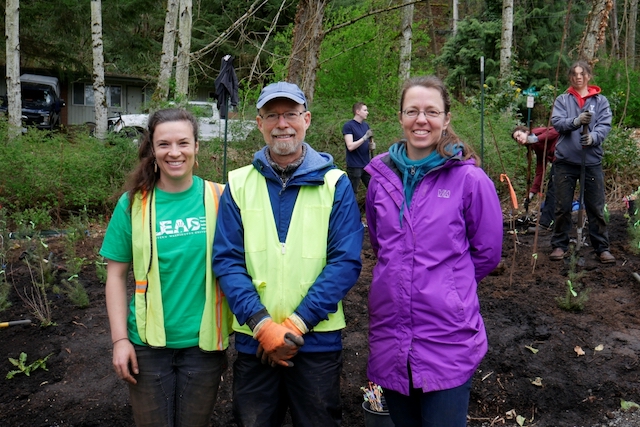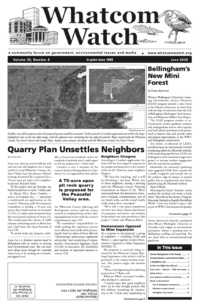by Emma Bjornsrud
Western Washington University’s Learning, Environment, Action, Discovery (LEAD) program planted a mini forest at the Sehome Arboretum on Earth Day with the help of volunteers from the City of Bellingham, Washington Trails Association and Whatcom Million Trees Project.
The LEAD program consists of environmental studies graduate students and undergraduate interns who organize and lead habitat restoration work parties, teach a seminar class and provide other educational opportunities to the WWU and Bellingham communities.

Ava Stone, Michael Freer and Hananh Lewis (left to right) helped organize the Earth Day event.
photo: Sky Bressette, City of Bellingham
Ava Stone, co-director of LEAD, stumbled upon an international method of planting called the Miyawaki method, while researching agroforestry. LEAD was looking for a more consistent, longer-term project to increase student engagement after the coronavirus pandemic.
Meanwhile, the university’s gardening team suggested LEAD find a project for a small, overgrown and unused site on the northern edge of campus. It seemed perfect for an experimental mini forest planted using the Miyawaki method.
How It Works
Minneapolis-based Hannah Lewis studied the method and wrote a book titled: “Mini-Forest Revolution: Using the Miyawaki Method to Rapidly Rewild the World.” Lewis was invited to give a talk as part of WWU’s Environmental Speaker Series on April 20 and attended LEAD’s Earth Day event that weekend.
In her presentation, Lewis explained how the Miyawaki method of landscaping and ecosystem regeneration cultivates a dense, biodiverse mini forest that can grow quickly in small places around the areas where we live and work. People have planted forests using the Miyawaki method in more than 3,000 places internationally since Akira Miyawaki, a Japanese botanist, developed the method in the 1960s and 1970s.
LEAD began to organize a big planting party using the Miyawaki method at the north campus site, and reached out to the City of Bellingham and local nonprofits like the Washington Trails Association and the Whatcom Million Trees Project, which often partners with LEAD and the city.
The city hosts work parties around town weekly on Saturdays, and Earth Day is one of their events with the most participation each year. The city registered 178 volunteers to work on the planting, and provided staff and resources for the event.
The city’s parks volunteer program is partially funded by the Greenways Levy, and LEAD also received grant funding for the event, said Sky Bressette, the volunteer program restoration educator for the city’s parks department.
LEAD Graduate Students
LEAD graduate students said their work on the site began in September and continued throughout the fall and winter, with the removal of invasive species. The internal LEAD team researched how to apply the Miyawaki method to the site, and held work parties with volunteers to do the physical work on the ground.
After about six months of clearing the site, it was ready for planting. The LEAD interns chose native plants, planned out their locations at the site and created procedures for the event. At the same time, four interns also rebuilt the LEAD website, created event posters and advertised it on social media.
“They are frickin’ rock stars,” said Brandon McWilliams, one of the LEAD co-directors.
Earth Day brought beautiful weather, and volunteers arrived ready to be given instructions. Hannah Lewis was there to share her expertise and advice, and Bellingham Mayor Seth Fleetwood joined the event in the afternoon to give a brief speech.
After a demonstration from LEAD, volunteers planted native large canopy plants and sub-canopy plants. Shrubs and ferns mixed together across the site. This technique in urban spaces creates healthy ecosystems that can reduce temperatures, increase biodiversity and prevent flooding and droughts.
“It’s really satisfying to see everything work out,” McWilliams said. “We really weren’t sure how it was all gonna go, and Saturday went so smoothly, we got everything done. It was awesome — really gratifying to have like, months and months of prep work and behind the scenes stuff come to fruition.”
McWilliams said there is still some wrapping up to do at the mini-forest site before the project is complete. LEAD installed a gate at the entrance and a fence around the perimeter of the site to keep the deer out. With Whatcom Million Trees Project, they are working to create an informational sign to notify visitors about the site and the Miyawaki planting method.
Other Sites on Campus
In the coming months, McWilliams said they will be working closely with the grounds team to identify other spaces on campus that could be restored. They said a site like the drainage ponds on south campus could be another larger-scale project to increase continuity and engagement.
This was McWilliams’ first year as a LEAD co-director, and they (McWilliams prefers nonbinary pronouns) are currently hiring a co-director to work alongside for the next year. They said so much knowledge goes through the program that it can be challenging to document it all.
“This was such a prototype, that a lot of the work was just like, how did we do any of this? So now that we’ve done it once, the hope is that it’s a little easier next time,” McWilliams said.
Michael Feerer, Whatcom Million Trees Project’s executive director, said he thinks the Miyawaki method was a cool technique to apply here.
“As a demonstration mini forest for this area, especially as we wait over the next year or two to see how it evolves and thrives at its location, I think there could be, very well, other mini forests proposed in our area for certain tight urban sites,” Feerer said.
Whatcom Million Trees Project
Whatcom Million Trees Project is just two years old and has more than 500 volunteers on its on-call list. Feerer said their mission is less about the number of trees planted, and more about the sense of empowerment that can be cultivated within the community to help cope with the climate crisis.
“When I started the nonprofit, I was hoping that it would begin to build a movement in this community for trees and forests, and it’s really starting to feel like that now,” Feerer said.
Their mission also includes goals to plant new seedlings and protect mature trees in our area, which are especially effective at capturing carbon and providing habitat for biodiverse ecosystems. They have created neighborhood tree ambassador programs to protect the trees on the streets, and partner with local businesses to fundraise for tree plantings and supplies.
“Trees are an important part of what this community is about — a big reason why a lot of people move here, but yet, we’re losing a lot of tree canopy over time to various pressures,” he said.
Individual donations, the business partnerships and grants largely fund the project, but Feerer said he is excited for the city to complete its Urban Forestry Management Plan (1) with the hope that more state and federal grant funding will be available after the study has been completed.
Additionally, Feerer said Whatcom Million Trees has had some involvement in determining the “tree-equity-challenged” neighborhoods (2) in Bellingham. They have received local small grant funding to research the socioeconomic indicators of neighborhoods in the city with more tree canopy, which can be up to 10 degrees cooler, reduce the effects of flooding and contribute to cardiovascular health and emotional wellbeing.
Ways to Get Involved
Visit the Miyawaki Mini-Forest. The site runs parallel to Billy Frank Jr. St. just north of WWU’s 7G parking lot. Enter through the black gate to experience the mini forest.
Warmer weather brings outdoor work parties. Check out local volunteer opportunities from WWU’s LEAD (3), the City of Bellingham (4), Whatcom Million Trees Project (5), Washington Trails Association (6), Nooksack Salmon Enhancement Association (7) and Whatcom Land Trust (8).
Sources
1. https://cob.org/services/planning/environmental/ufmp
3. https://cenv.wwu.edu/lead/volunteer
4. https://cob.org/gov/public/volunteer/parks-volunteer
5. https://whatcommilliontrees.org/volunteering/
6. https://www.wta.org/get-involved/volunteer
7. https://www.n-sea.org/work-1
8. https://whatcomlandtrust.org/volunteer/
____________________________
Emma Bjornsrud (they/she) graduated from Western Washington University in December with a degree in environmental journalism. Emma is spending time in Bellingham working and reporting. You can email them at emmab.journalism@gmail.com.




























